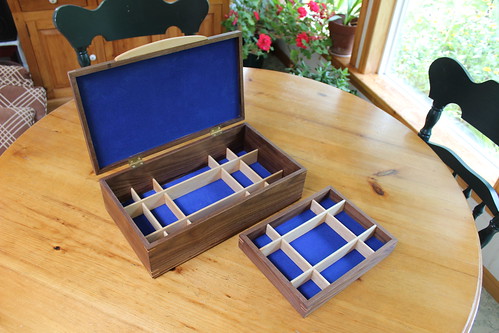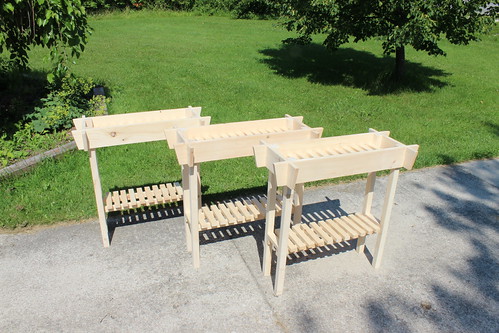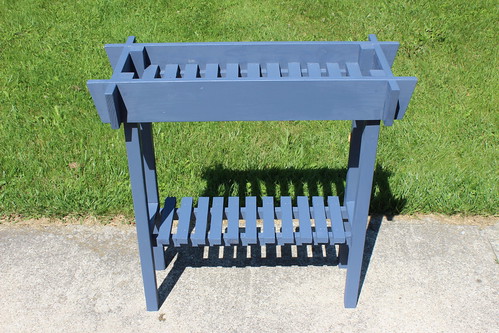A while ago I built a footstool with an upholstered top. This time around it was pretty much the same design, except this time a hardwood top was requested. The lid is made of bookmatched walnut with a zebrawood feature stripe. The top opens on two brass hinges, with room inside for a few magazines or a pair of slippers.
Canarywood Box
Another Swivel Clock
I made a couple of these just over a year ago, and then realized the other day I still had one clock mechanism left. It wasn’t doing anyone any good sitting in a drawer, so I made the clock to go around it. This one is purpleheart with curly maple.
This is one of the older ones I did. Pretty much identical except for the wood choice (wenge and curly maple).

From a design by The Wood Whisperer.
Two New Jewelry Boxes
Just finished the third of three large jewelry boxes, which have occupied most of my summer and fall, off and on. Also included here is a tiny little box that took only a day to construct (but then some time on the finishing and flocking). The large box is finished just in time to qualify for free shipping to the client (my wife is driving down to the city next week).
As always, click any photo to view larger on Flickr.

“Say hello to my leetle friend”

A tiny bit larger than the last two large jewelry boxes in this series, this one measures about 9″ x 15″ and about 5″ tall.

Two pieces of bookmatched quilted maple, divided by a walnut strip, make a simple lid design that lets the wood do the talking.

Lots of scope with this large box containing 30 separate compartments of various sizes. The blue flocking sets it off nicely.

Shown here with the upper tray removed.

About 4 1/2″ square by 4″ tall, with the lid. From a test piece I cut while building the larger box, I thought this would make a sweet little box of its own.

Zebrawood lid is just rabbeted to fit, shown here removed to display the blue flocking inside.
All of my recent boxes have employed mitred corners with mitre keys for style and more importantly to improve the glue bond at the corners. Other similar construction techniques were used on all of them, like the way the lids are made, and the way the hinges are attached. Think I need to shake things up for the new year, but not sure how yet.
Thanks for looking! And remember, click any photo to view larger on Flickr.
Tea Light Candle Holders
(click photo to view larger on Flickr)
This is a pair of small tea light candle holders, based almost entirely on a design by Steve Ramsey of “Woodworking for Mere Mortals”. You can see the original if you click here.
The only thing I changed was that I cut a bit of an angle from the ends of the maple pieces, rather than leave them just square and straight. The other thing I changed, somewhat reluctantly, is that I made the shallow holes for the candles a bit wider, because the “right-sized” holes seemed a bit unsafely undersized for these candles. The wood species used are maple and purpleheart.
Lacewood and Purpleheart Jewelry Box
Just finished this new jewelry box (finally) made of lacewood and purpleheart. Lacewood is also known as Australian Silky Oak.
(As always, click any photo to view larger on Flickr)

Overall view of the box with the lid closed.

Detail of the top of the box… The plugs were cut using a plug cutter, from the same lacewood that forms the rest of the box.

Open view of the box. The tray slides back and forth, providing access to the lower compartments on the side, or may be lifted out to access the central compartments.

Showing the tray removed, for full access. The blue stuff is called “flocking” – it’s like tiny blue fibres blown onto some colour-matched adhesive applied to the box. It’s not a hundred percent cured yet, so some final “grooming” will be needed in a couple of days.

This shows the Brusso hinges, or one of them, and the purpleheart mitre splines that strengthen the corners as well as providing accents matching the lid.
Walnut Jewelry Box
I finally completed this walnut jewelry box. The top is made of pine, and some hard maple was also used for the handle and dividers. The box is finished with Deft Danish Oil Finish, with a few flakes of beeswax melted into the mixture using the microwave. I’m not yet sure what will become of this box — I have another in progress, and I will offer Lynda her choice when they are both done.
As always, click any photo to view larger on Flickr.

Top view: The five dots are just small segments of dowel tapped into shallow holes. A nice easy way to give the otherwise plain top a bit of style. I give credit to my wife for this variation on that theme. I had something else in mind, but this is better.

Inside view: The sliding tray is sized to allow access to the six small compartments on each end of the lower section. The tray may be lifted out to access the larger central compartments underneath it.

Inside view, tray removed: The central compartments in the lower section are sized for larger items. The blue flocking gives it a posh look, kind of. The Brusso hinges are certainly posh.

Corner view: The mitre keys inset into the corners are both decorative and practical, serving to reinforce the glue joints.
Cherry iPad Stand
This is a stand for the iPad2, made from Cherry. That is, the stand is made from cherry. Not the iPad.
I had previously made, and deployed, a very similar stand for the original iPad, but the iPad 2 has buttons on the side that made the old stand problematic. This new one addresses that by having a shorter support piece. The switch just hangs over empty space now.
The joinery is stop-routed mortises and offset tenons. Offset because I routed the mortises in the wrong place. But you’d never know that, so I’m not sure why I mention it.
The iPad belongs to my wife. Actually so does the stand, as soon as she pays me for the wood.
We Stand For Plants
These are some outdoor plant stands, just made out of contruction lumber and pine shelf boards from Home Depot. They still need to be painted – my wife will take over from here. She doesn’t hate painting.
A single coat of Benjamin Moore’s highest quality outdoor paint, should stand up to weather and watering for a couple of years at least…
Fountain Pen
I just made five of these beauties. One has gone to my wife, who is sophisticated enough to actually use it properly, I expect. Two are going off in the mail to my sister, who has a buyer for one already. Leaving two to have for sale here. I won’t be using one myself, I’m not optimistic I would manage it without making a big mess.
I”ve just learned that you can install either the cartridge, for the self-contained thing, or else this little pumpy thing, which draws up ink from an inkwell, for that traditional writing experience.
The wood is Bethlehem Holy Land olive wood (certificate of authenticity included), the pen style is "Sedona" (same as the Rollerball pens I’m so fond of) and it’s gold plating.











